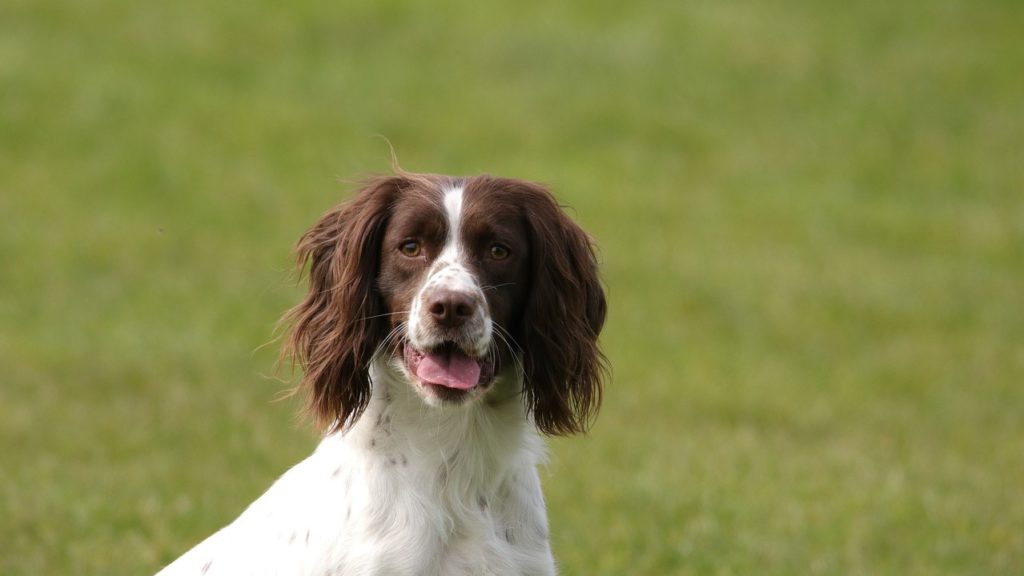Study finds that using dogs to survey for citrus greening disease is more accurate and efficient than current methods.

Huanglongbing, or citrus greening disease, is a bacterial disease of citrus plants cause by Candidatus Liberibacter spp. It is thought to have been primarily an insect endophyte, but made the jump to its alternative host – citrus plants – within the last 200 years. As a result, these plants have not had an opportunity to co-evolve with the disease, resulting in a complete lack of resistance or tolerance throughout the Citrus genus. This has led to huanglongbing being one of the most severe pandemics of horticultural crops in modern times.
Dogs and humans have a long and complicated history. Throughout, dogs have been valued not only for their companionship and loyalty, but also for their utility, and in many cases this usefulness is driven by their nose. Dogs have extremely acute olfactory senses, which allowed them to be employed as hunting dogs as long as 12,000 years ago, and renders them invaluable in a wide range of disciplines today. Dogs are used to search for drugs, bombs and people, and are used in medicine for their ability to sense the volatile organic compounds associated with cancer or diabetes-related events. They are increasingly used in finding rare and endangered species for conservation and ecological purposes, and are even used to find invertebrate pests like bedbugs in hotels.
New uses for ‘sniffer dogs’ are tested regularly, and many demonstrate high levels of success. With huanglongbing threatening the citrus industry across the world, researchers from the US Department of Agriculture have investigated the potential of dogs as detectors of the disease, with the results published in the Proceedings of the National Academy of Sciences this month.

One of the primary challenges of detecting huanglongbing in citrus plants is that the bacteria are erratically distributed within the vascular system of infected trees. This makes it impossible to guarantee that the sections of tree that are sampled for disease testing contain the bacteria, which can cause false negative results. Accurate detection of huanglongbing therefore relies heavily on human visual confirmation of symptoms. This presents an additional challenge, however, as the disease has an incubation period of several months to a year before symptoms are clearly visible, which provides a significant window of opportunity for the disease to spread before it is detected. This study was therefore focused on the value of dogs as an early warning system.
The researchers carried out a three-phase study, gradually introducing two teams of ten dogs to infected trees. The first phase involved each dog being presented with four potted specimens (prepared using Valencia orange Citrus sinensis or Ruby Red grapefruit Citrus paradise on rough lemon Cirturs jambhiri rootstock), one of which had been infected with huanglongbing. The dogs would eventually identify that one specimen was different, and were rewarded. The following phases involved increased numbers of trees and randomised placement of infected trees followed by multiple rows of trees in a simulated orchard environment.
Once the dogs had been fully trained to recognise the scent of infected trees, repeated further tests were carried out to test their detection performance and accuracy. Overall, the dogs had an accuracy of 0.9905, or 99.05%, and the researchers were able to identify that there were no statistically significant performance differences based on time, different handlers and individual dogs. When two dogs were used to gain consensus of detection, this accuracy was raised to almost 100%.
These results clearly demonstrate that dogs have the capacity to act as an early warning system for huanglongbing, allowing growers to identify and remove infected trees before the disease is able to spread. Trained dogs are able to sample a tree in approximately 2 seconds, which is significantly faster than the standard procedure of sampling, processing and assaying each tree. The results also indicate that dogs are able to identify the pathogen directly, rather than reacting to the chemical responses of an infected plant, which makes their use equivalent to existing testing methods from a regulatory perspective. The use of dogs in detecting crop pathogens is direct and immediate, and teams have already been deployed in Southern California.
This study shows that dogs may prove to be an invaluable ally in the fight against huanglongbing, but citrus greening disease is far from the only pathogen threatening the stability of horticultural industries across the world. The researchers suggest that dogs could be trained to recognise multiple pathogens simultaneously, so there may be many other crops and other diseases that this survey technique could be applied to.
The full article is available on the Proceedings of the National Academy of Sciences website: Canine olfactory detection of a vectored phytobacterial pathogen, Liberibacter asiaticus, and integration with disease control.
To find similar articles, visit CABI’s Horticultural Science Database and use the search huanglongbing OR (“sniffer dogs” OR (“canine detection” AND crop*))
Or see below:
Odor perception by dogs: evaluating two training approaches for odor learning of sniffer dogs.
Research progress on detection technology of citrus huanglongbing.
More on this research:
These dogs can smell tree disease – and could help save the world’s orange groves
Trained Dogs Are the Most Efficient Way to Hunt Citrus Industry’s Biggest Threat
2 Comments
Leave a Reply
Related News & Blogs
Biological control in action: Zambia’s field days on fighting fall armyworm
Experts from CABI recently held two field days and an expo in Zambia, showcasing innovative approaches to pest management to 584 farmers, agro-dealers and other stakeholders to help raise awareness of approaches to tackle the invasive fall armyworm (Sp…
11 June 2025





[…] more on this amazing discovery about one of humans long-standing companions: Dogs can sniff out huanglongbing months before symptoms appear (Website […]
[…] Dogs can sniff out huanglongbing months before symptoms appear […]